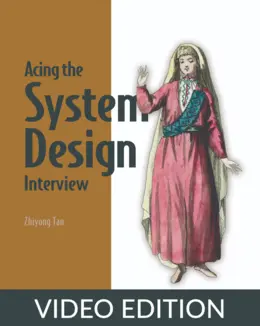Acing the System Design Interview, Video Edition

Acing the System Design Interview, Video Edition
English | MP4 | AVC 1280×720 | AAC 44KHz 2ch | 17h 03m | 2.80 GB
The system design interview is one of the hardest challenges you’ll face in the software engineering hiring process. This practical Acing the System Design Interview, Video Edition gives you the insights, the skills, and the hands-on practice you need to ace the toughest system design interview questions and land the job and salary you want.
In Acing the System Design Interview, Video Edition you will master a structured and organized approach to present system design ideas like:
- Scaling applications to support heavy traffic
- Distributed transactions techniques to ensure data consistency
- Services for functional partitioning such as API gateway and service mesh
- Common API paradigms including REST, RPC, and GraphQL
- Caching strategies, including their tradeoffs
- Logging, monitoring, and alerting concepts that are critical in any system design
- Communication skills that demonstrate your engineering maturity
Don’t be daunted by the complex, open-ended nature of system design interviews! In this in-depth guide, author Zhiyong Tan shares what he’s learned on both sides of the interview table. You’ll dive deep into the common technical topics that arise during interviews and learn how to apply them to mentally perfect different kinds of systems.
The system design interview is daunting even for seasoned software engineers. Fortunately, with a little careful prep work you can turn those open-ended questions and whiteboard sessions into your competitive advantage! In this powerful tutorial, Zhiyong Tan reveals practical interview techniques and insights about system design that have earned developers job offers from Amazon, Apple, ByteDance, PayPal, and Uber.
Acing the System Design Interview, Video Edition is a masterclass in how to confidently nail your next interview. Following these easy-to-remember techniques, you’ll learn to quickly assess a question, identify an advantageous approach, and then communicate your ideas clearly to an interviewer. As you work through this book, you’ll gain not only the skills to successfully interview, but also to do the actual work of great system design.
